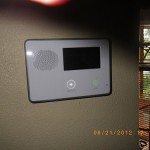 The bags are packed everyone’s in the car, and you’re on your way to a great vacation destination. But, did you lock the front door?
The bags are packed everyone’s in the car, and you’re on your way to a great vacation destination. But, did you lock the front door?
Does that sound like something that has happened to you? If so, then you’re not alone. Fortunately, there’s a new device on the market that can prevent it from ever spoiling your getaway again. Called Lockitron, it’s the brainchild of a small group of crowd-sourced entrepreneurs. Their vision is to bring the benefits of the information age to one of the oldest inventions in the modern home: the door lock.
Lockitron
The genius of the Lockitron lies in its simplicity. It slips directly over a standard deadbolt and has a small, battery-powered electric switch operated by a remote control. “Remote” means anywhere on earth with an Internet connection. By using a web-capable device, Lockitron owners can lock or unlock any door in their home fitted with the product. It works as well with touchscreen as with a traditional mouse, and it can be operated via smartphones, tablets or even the rumored Apple iWatch.
The Lockitron is only the latest in a series of automation devices for the home that are enabling consumers to control what goes on in their homes, whether they’re there or on the other side of the planet. The functions that can now be automated include security systems, interior/exterior lighting, curtains and blinds, surveillance cameras, thermostats, and watering systems. Even coffee makers can be activated from a distance so that commuters arriving home after a long day of work can be greeted with a fresh cup of coffee when they walk in the door.
Do-It-Yourself Projects
Adding to this appeal of home automation noted by SecurityCompanies.com, is the fact that DIYers can easily install the necessary components on their own. Here’s a look at the options available, listed according to capabilities and complexity:
The simplest devices allow buyers to turn any device plugged into an outlet on or off at will. The Belkin WeMo is perhaps the best product in this category. It operates directly through the home’s Wi-Fi and is directed by an iOS app on the owner’s smartphone (an Android version is due out this summer).
The next step is to tie your systems into a centralized unit that you can program either on-site or at a distance. The device, in turn, will switch lights off and on, raise and lower the thermostat, activate the security system, and more, according to your prior instructions, but you can always override it if you choose. You’ll need software, a transceiver, and various switches and sensors throughout your home. Some of the products that fit within this category are Z-Wave, Zigbee, and X10.
Building Your Own Devices
For the ultimate in options (and also complexity), you can build your own devices from circuit boards and other components available for the serious home automation geeks. You’ll need both programming experience and familiarity with electronics. For those who are up to the challenge, platforms like Arduino and Raspberry Pi are good starting points.
Whatever level of home automation strikes your fancy, you’ll enjoy capabilities that were once the stuff of science fiction. Robot maids and butlers aren’t here just yet, but they may be just around the corner.
Image by osseous pursuant to the terms of Creative Commons license.

